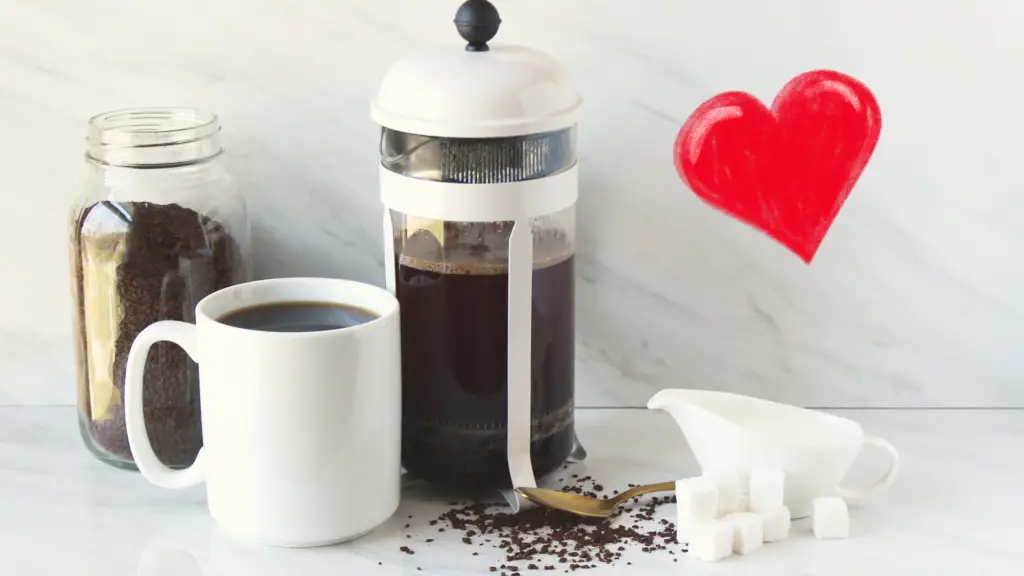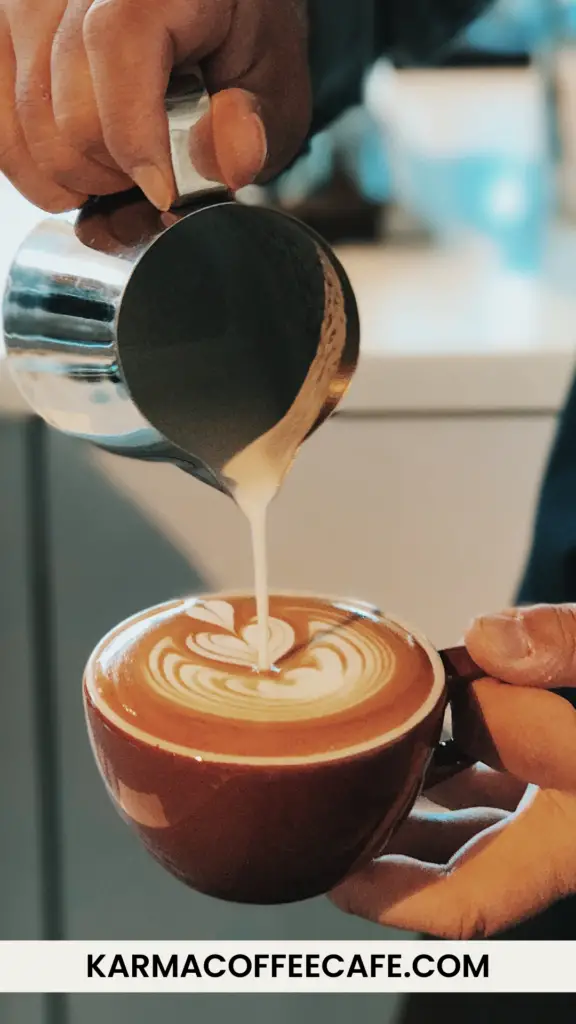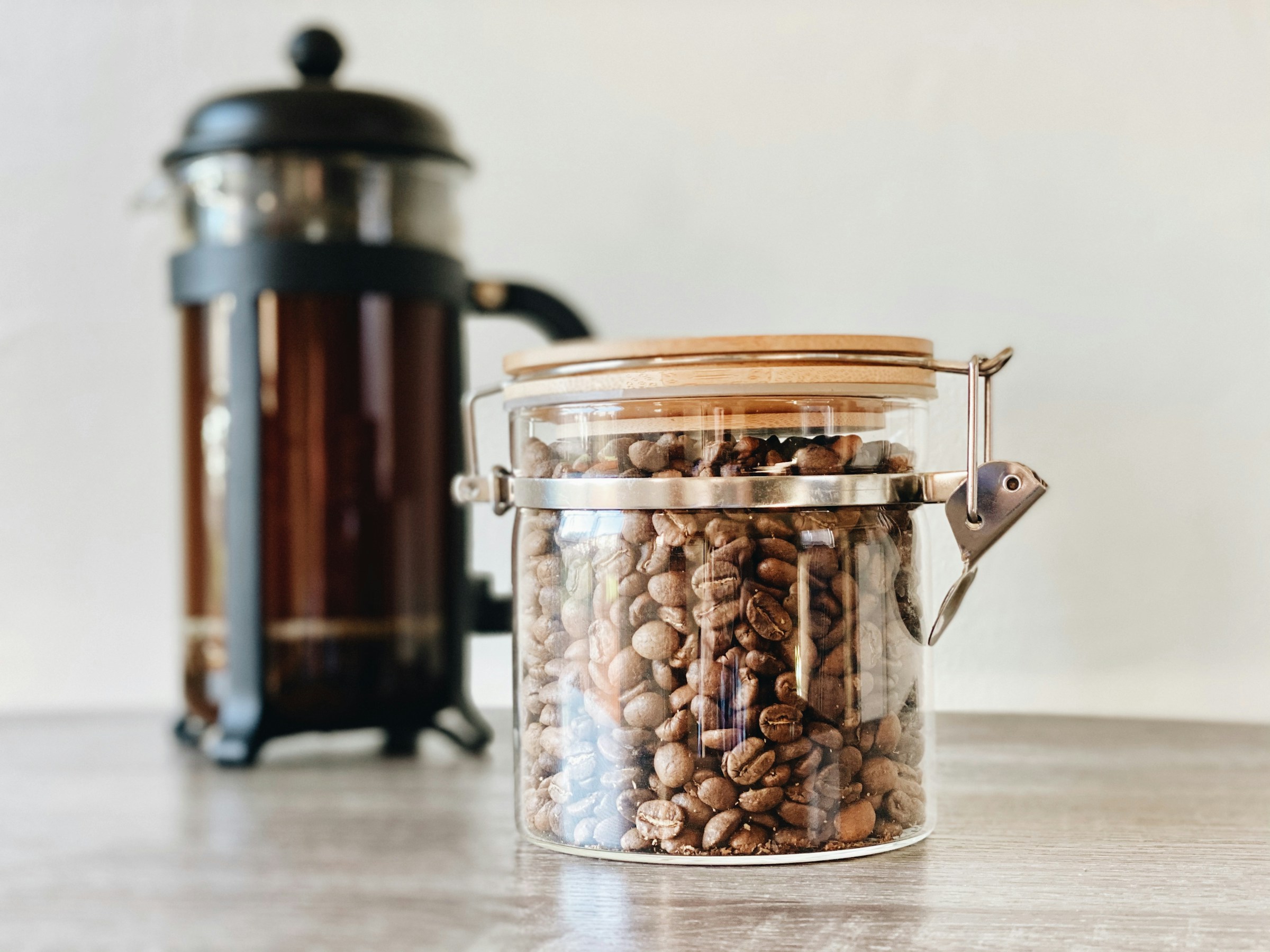Making a latte with a French press is simpler than you think.
French press lattes are rich, creamy, and full of flavor.
This method lets you skip the coffee shop and enjoy a delicious latte at home.
With just a few tools and ingredients, you can craft a barista-quality drink in your kitchen.
Plus, you can customize it to your taste.
Ready to learn how? Let’s get started!

How To Make A Latte With A French Press: At A Glance
- Step 1: Preparing the Coffee
- Step 2: Heating and Frothing the Milk
- Step 3: Combining Coffee and Milk
- Step 4: Enjoy!
Equipment and Ingredients Needed

French Press
A French press is essential for making this latte.
It’s a simple and effective way to brew coffee.
Ensure your French press is clean and ready to use.
This will help you get the best flavor from your coffee.
Milk Frother or Alternative (Mason Jar and Microwave)
To froth your milk, you can use a milk frother.
If you don’t have one, a mason jar and microwave work just as well.
Coffee Grinder (If Using Whole Beans)
If you prefer using whole coffee beans, a coffee grinder is necessary.
Grinding your coffee just before brewing ensures a fresh and rich flavor.
Set your grinder to a coarse setting for the French press.
Freshly Ground Coffee (4 Tablespoons)
Use 4 tablespoons of freshly ground coffee.
Fresh coffee beans give the best taste.
You can use pre-ground coffee, but freshly ground beans will enhance the flavor.
Water (8 oz)
Boil 8 ounces of fresh, filtered water.
The water should be just below boiling point, around 200°F.
This temperature helps extract the perfect flavor from the coffee grounds.
Milk (10 oz; Soy, Almond, or Whole Milk)
You’ll need 10 ounces of milk for your latte.
You can use soy, almond, or whole milk depending on your preference.
Each type of milk offers a different texture and flavor, so feel free to experiment.
Step-by-Step Guide to Making a Latte with a French Press

Step 1: Preparing the Coffee
1. Boil Water to Just Below Boiling Point (200°F)
Boil fresh, filtered water and let it cool slightly.
Aim for around 200°F.
This temperature is ideal for extracting the best flavors from the coffee grounds.
2. Grind Coffee Beans to a Coarse Texture
If using whole beans, grind them to a coarse texture.
This consistency is perfect for a French press and prevents over-extraction, which can make the coffee bitter.
3. Add Ground Coffee to French Press
Place 4 tablespoons of the ground coffee into the French press.
This amount is sufficient for a rich and robust flavor.
4. Pour a Small Amount of Hot Water Over Grounds to Bloom
Pour just enough hot water over the coffee grounds to wet them completely.
Let it sit for 30 seconds.
This process, known as blooming, releases gases and enhances the coffee’s flavor.
5. Add the Rest of the Hot Water
Pour the remaining hot water into the French press, filling it up to the top.
This ensures the coffee grounds are fully immersed.
6. Stir Gently and Cover with Plunger
Stir the mixture gently to combine the coffee grounds with the water.
Place the plunger on top of the French press, but do not press it down yet.
This helps retain heat and flavor.
7. Let Steep for 4 Minutes
Allow the coffee to steep for 4 minutes.
This time is perfect for extracting the rich, full-bodied flavors without over-extracting.
Step 2: Heating and Frothing the Milk
1. Methods to Heat Milk (Stovetop, Microwave)
Heat the milk using a stovetop or microwave.
On the stovetop, warm the milk in a saucepan over medium heat.
If using a microwave, pour the milk into a microwave-safe container and heat for 1-1.5 minutes.
2. Frothing Techniques (Using a Milk Frother, French Press, or Mason Jar)
Use a milk frother for best results.
If you don’t have one, pour the heated milk into a French press and pump the plunger up and down until the milk froths.
Alternatively, use a mason jar: fill it halfway with milk, shake it vigorously, and then microwave for 30-45 seconds.
3. Target Temperature for Milk (140-155°F)
Heat the milk to between 140°F and 155°F.
This range is optimal for frothing and ensures a creamy texture without scalding the milk.
4. Froth Milk Until It Doubles in Volume
Froth the milk until it approximately doubles in volume.
This creates a smooth, velvety foam that is essential for a perfect latte.
Step 3: Combining Coffee and Milk
1. Press Down the French Press Plunger Slowly
After the coffee has steeped for 4 minutes, press the plunger down slowly and evenly.
This separates the coffee grounds from the liquid, leaving you with a smooth brew.
2. Pour Brewed Coffee into a Mug, Filling Halfway
Pour the brewed coffee into your mug, filling it about halfway.
This leaves enough room for the milk and foam.
3. Add Steamed Milk, Holding Back Foam with a Spoon
Pour the steamed milk into the coffee, holding back the foam with a spoon.
This ensures the milk mixes well with the coffee.
4. Scoop Foam on Top of the Latte
Finally, scoop the remaining foam on top of the latte.
This adds a luxurious texture and completes your homemade French press latte.
Enjoy!
Customizing Your Latte

Flavor Additions
Customizing your latte with flavors can enhance your coffee experience.
Here are some popular options:
- Cinnamon, Nutmeg, Cocoa Powder: Add a teaspoon of cinnamon or nutmeg to the milk before frothing for a warm, spicy touch. A tablespoon of cocoa powder can turn your latte into a delicious mocha.
- Vanilla Extract, Honey, Almond Extract: Add a drop or two of vanilla extract for a sweet, aromatic flavor. A tablespoon of honey can provide natural sweetness. Almond extract (about a teaspoon) offers a rich, nutty flavor.
- Simple Syrups (Maple, Peppermint): Stir in a tablespoon of maple syrup for a sweet, earthy taste. A splash of peppermint syrup can give your latte a refreshing, festive flavor.
Milk Variations
Different types of milk can change the texture and flavor of your latte:
- Whole Milk: Provides a rich, creamy texture that froths well and adds a smooth, full-bodied flavor.
- Almond Milk (Kirkland Brand Recommended): Known for its good frothing properties, almond milk from Kirkland is a great alternative. It offers a light, nutty flavor that complements coffee.
- Soy Milk: Soy milk is another good frothing option, offering a slightly sweet and creamy texture. It’s a popular choice for those avoiding dairy.
- Oat Milk: Oat milk froths nicely and adds a slightly sweet, mild flavor. It’s a great choice for a creamy, non-dairy latte.
Tips for the Perfect Latte

Importance of Coffee-to-Milk Ratio (1:3 or Adjusted to Preference)
The ideal coffee-to-milk ratio for a latte is typically 1 part coffee to 3 parts milk.
This ratio provides a balanced flavor where the coffee is prominent but not overpowering.
However, this can be adjusted based on personal preference.
If you prefer a stronger coffee flavor, you can decrease the amount of milk.
Conversely, if you like a creamier latte, increase the milk portion.
Ensuring Even Extraction of Coffee
Even extraction is key to a great-tasting latte.
To achieve this, make sure your coffee grounds are evenly distributed in the French press.
When adding water, pour it in a circular motion to ensure all grounds are saturated.
Stir gently after adding water to further ensure even extraction.
Uneven extraction can lead to a bitter or weak taste, so take your time with this step.
Maintaining the Right Milk Temperature for Frothing
The temperature of the milk is crucial for achieving the perfect froth.
As mentioned earlier, the ideal temperature range for frothing milk is between 140°F and 155°F.
Milk within this range will have the right texture and sweetness.
If the milk is too hot, it can scald and lose its ability to froth properly.
Using a thermometer can help you maintain the correct temperature.
Conclusion
Making a latte with a French press is simple and rewarding.
You can enjoy a rich, creamy latte at home without needing fancy equipment.
Plus, it offers the flexibility to experiment with different flavors and milk types.
Try various combinations to find your perfect cup.
Enjoy the process and the delicious results!


